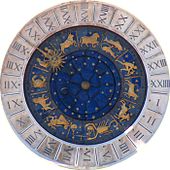
Back الشمس كعلامة تنجيم / التكهن بالشمس Arabic सूर्य (ज्योतिष) Bihari Bulvární astrologie Czech Astrologie populaire French 星座占い Japanese 태양궁 점성술 Korean Torovintana Malagasy Zonnetekenastrologie Dutch
| Astrology |
|---|
 |
| Background |
| Traditions |
| Branches |
| Astrological signs |
| Symbols |
Sun sign astrology, or star sign astrology, is a modern simplified system of Western astrology which considers only the position of the Sun at birth, which is said to be placed within one of the twelve zodiac signs, rather than the positions of the sun and the other six 'planets'. This sign is then called the sun sign or star sign of the person born in that twelfth-part of the year. Sun sign astrologers take this basic twelve-fold division and relate all the current movements of all the planets to each other, using traditional rules to divine meanings for each sign separately.[citation needed] Because the Moon has the fastest apparent movement of all the heavenly bodies, it is often used as the main indicator of daily trends for sun sign astrology forecasts.[citation needed]
Sun sign astrology is a pseudoscience[1][2] and the form of astrology most commonly found in many newspaper and magazine columns. Scientific investigations of the theoretical[3]: 249, [4] basis and experimental verification of claims[5][6] have shown it to have no scientific validity or explanatory power.[7]: 85,
- ^ Sven Ove Hansson; Edward N. Zalta. "Science and Pseudo-Science". Stanford Encyclopedia of Philosophy. Retrieved 6 July 2012.
There is widespread agreement for instance that creationism, astrology, homeopathy, Kirlian photography, dowsing, ufology, ancient astronaut theory, Holocaust denialism, Velikovskian catastrophism, and climate change denialism are pseudosciences.
- ^
Hartmann, P.; Reuter, M.; Nyborga, H. (May 2006). "The relationship between date of birth and individual differences in personality and general intelligence: A large-scale study". Personality and Individual Differences. 40 (7): 1349–1362. doi:10.1016/j.paid.2005.11.017.
To optimise the chances of finding even remote relationships between date of birth and individual differences in personality and intelligence we further applied two different strategies. The first one was based on the common chronological concept of time (e.g. month of birth and season of birth). The second strategy was based on the (pseudo-scientific) concept of astrology (e.g. Sun Signs, The Elements, and astrological gender), as discussed in the book Astrology: Science or superstition? by Eysenck and Nias (1982).
- ^ Vishveshwara, edited by S.K. Biswas, D.C.V. Mallik, C.V. (1989). Cosmic Perspectives: Essays Dedicated to the Memory of M.K.V. Bappu (1. publ. ed.). Cambridge, England: Cambridge University Press. ISBN 978-0-521-34354-1.
{{cite book}}:|first=has generic name (help)CS1 maint: multiple names: authors list (link) - ^ Peter D. Asquith, ed. (1978). Proceedings of the Biennial Meeting of the Philosophy of Science Association, vol. 1 (PDF). Dordrecht: Reidel. ISBN 978-0-917586-05-7.; "Chapter 7: Science and Technology: Public Attitudes and Understanding". science and engineering indicators 2006. National Science Foundation. Archived from the original on 1 February 2013. Retrieved 2 August 2016.
About three-fourths of Americans hold at least one pseudoscientific belief; i.e., they believed in at least 1 of the 10 survey items[29]"... " Those 10 items were extrasensory perception (ESP), that houses can be haunted, ghosts/that spirits of dead people can come back in certain places/situations, telepathy/communication between minds without using traditional senses, clairvoyance/the power of the mind to know the past and predict the future, astrology/that the position of the stars and planets can affect people's lives, that people can communicate mentally with someone who has died, witches, reincarnation/the rebirth of the soul in a new body after death, and channeling/allowing a "spirit-being" to temporarily assume control of a body.
{{cite web}}: CS1 maint: bot: original URL status unknown (link) - ^ Carlson, Shawn (1985). "A double-blind test of astrology" (PDF). Nature. 318 (6045): 419–425. Bibcode:1985Natur.318..419C. doi:10.1038/318419a0. S2CID 5135208.
- ^ Zarka, Philippe (2011). "Astronomy and astrology". Proceedings of the International Astronomical Union. 5 (S260): 420–425. Bibcode:2011IAUS..260..420Z. doi:10.1017/S1743921311002602.
- ^ Jeffrey Bennett; Megan Donohue; Nicholas Schneider; Mark Voit (2007). The cosmic perspective (4th ed.). San Francisco, CA: Pearson/Addison-Wesley. pp. 82–84. ISBN 978-0-8053-9283-8.